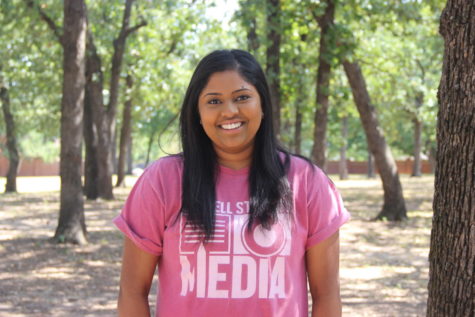A Celestial Experience: CHS students witness peak of solar eclipse
Coppell High School senior Jordan Whiteley observes the peak of the solar eclipse in front of the fieldhouse on Monday. All of the students used specialized glasses or homemade viewing devices to safely experience the phenomenon.
August 22, 2017
For most of the world, Monday is an ordinary day, the sun rising and setting as usual. However, for everyone in the United States, it was anything but ordinary as it is not only the first day of classes for Coppell High School students, but also an important, celestial event – the solar eclipse.
The solar eclipse is an astronomical phenomenon occurring when the moon’s shadow falls on the surface of the earth as its orbit comes between the Sun and the Earth.
A solar eclipse happens quite often but mostly occurs over water or unpopulated areas, which is why this year’s solar eclipse is highly anticipated across the country. In fact, today will be the first time the United States will be able to witness a total eclipse since Feb. 26, 1979.
Although Coppell does not lie on the path of totality, a narrow strip across the United States, and the rest of the world, where the moon will completely cover the sun, thus creating a period of total darkness, students at Coppell High School were given the opportunity to witness this “once-in-a-lifetime” event.
Armed with homemade solar eclipse viewers that were constructed out of cardboard boxes, aluminum foil and paper, and specialized glasses, students flooded out of their fourth period class to the parent loop to see the peak of the eclipse for those in Texas.
“It’s really cool that we can come out here and that the assistant principals and everybody gave us the opportunity to experience this natural process that’s going on in the sky, even though it’s our first day back to school,” CHS senior and Red Jacket Kyle Krautkramer said.
Having the solar eclipse fall on the same day as the first day of classes provided the school with an educational experience that many sciences took advantage of, especially the astronomy classes.
“Today was kinda crazy but a lot of fun. I was obviously excited having the solar eclipse happen when I got to be with all my students but I don’t know all of them very well,” Astronomy and Earth and Space Science teacher Angela Barnes said.
“It was a great first day activity, I think, and being outside and actually getting to see that together was a way to bond and get excited about the class. Hopefully, it’ll get them really excited about it. I can see a lot of interest in the subject, especially in my astronomy classes.”
While many of the students and faculty at the high school were able to witness part of the eclipse on campus, some students took the opportunity to view the complete eclipse by traveling to the cities in the path of totality.
Senior Jade Njo traveled to Hiawatha, Kan. to see the total eclipse at a viewing party filled with hundreds of other people. Although the weather called for some clouds which ended up covering the umbra, Njo was able to witness totality.
“The light had already been getting darker and darker as we viewed the sun being covered by the moon, but when full totality hit, it was something different,” Njo said.
“There was a sunset at 1 in the afternoon. It was bizarre and completely amazing. I’d never seen a ‘sunset’ like that. It was blue, pink, violet and wonderful and the clouds were a sort of violet-blue. It looked like there was a black dot in the sky with beautiful, bright orange around it.”
If you missed it, be sure to look out for the next solar eclipse in 2024, which will reach totality in Dallas.










